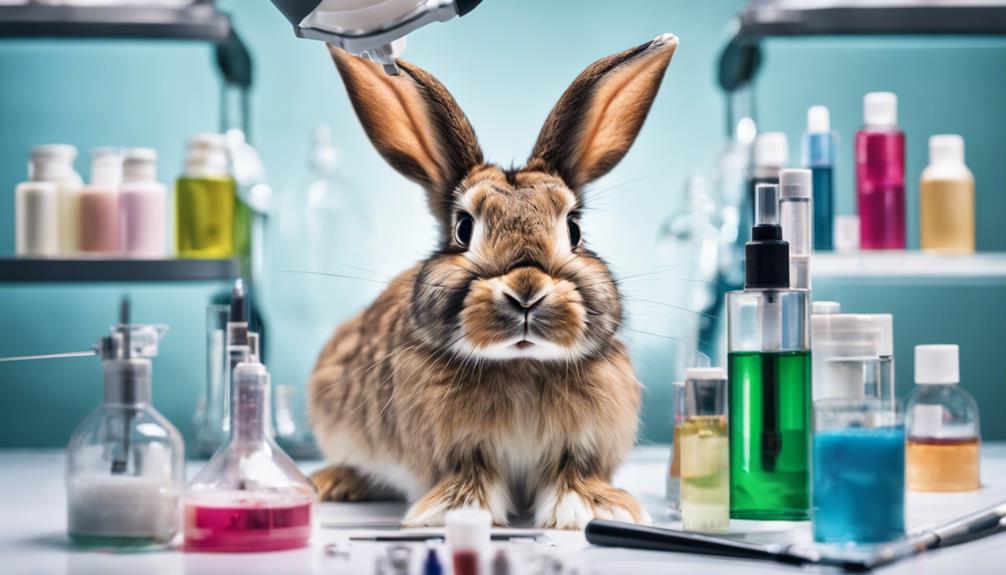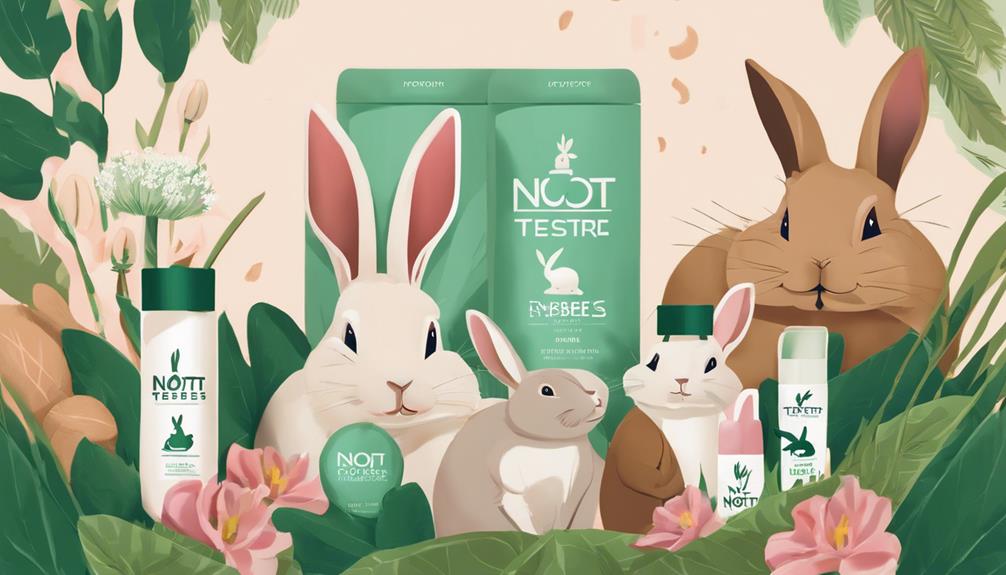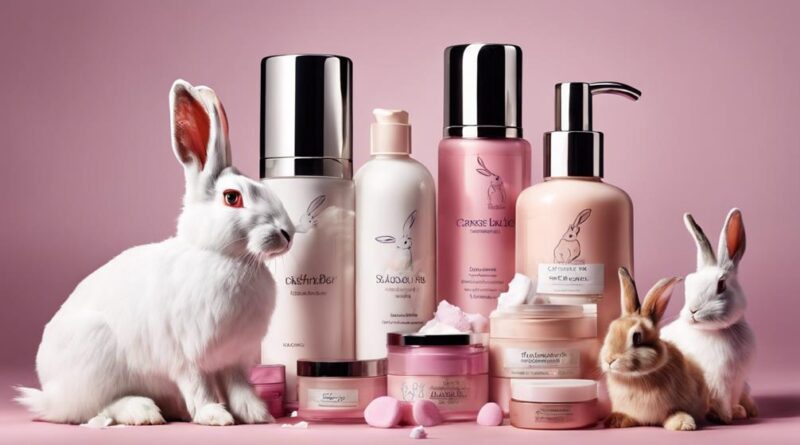10 Tips: Understanding Rabbit Use in Cosmetics Industry
To grasp rabbit use in the cosmetics industry, learn these 10 tips. Discover the historical significance of rabbit testing, from the Draize tests to ethical shifts. Uncover modern alternatives like in vitro methods and 3D skin models. Understand the strict regulations guiding ethical practices. Dive into ethical concerns driving brands to avoid rabbit testing for consumer trust. Explore rabbit anatomy's importance, from eyes akin to humans to sensitive skin considerations. Peek into the future where innovation and animal welfare intersect. Witness the impact of consumer demand for cruelty-free products shaping industry norms.
The History of Rabbit Testing
Throughout the development of the cosmetics industry, rabbit testing has been a prominent method used to assess the safety of products. Initially, in the mid-20th century, rabbits were chosen due to their docile nature and the ease of handling. The Draize eye and skin irritation tests, developed in the 1940s, became the standard for evaluating the potential harm of cosmetic ingredients. However, as awareness of animal rights grew, concerns regarding the ethics of rabbit testing emerged.
The evolution of rabbit testing saw increased scrutiny as scientific advancements offered alternative methods that were more ethical and accurate. While rabbit testing had been the norm for many years, the development of in vitro assays and artificial human skin models provided cruelty-free alternatives. These methods not only address the ethical concerns surrounding animal testing but also offer more reliable results due to their ability to mimic human biology more accurately.
Despite its long-standing history in the cosmetics industry, rabbit testing is now being phased out in favor of these cruelty-free alternatives. As society becomes more conscious of animal rights and the availability of advanced scientific techniques, the use of rabbits in cosmetic testing is gradually decreasing. This shift signifies a positive step towards a more humane and efficient approach to ensuring product safety.
Alternatives to Rabbit Testing
In the realm of cosmetic safety assessment, various alternatives to rabbit testing have emerged as more ethical and accurate methods. With the advancement of technology, animal-free methods are now being widely adopted in the cosmetics industry. These alternatives not only provide a more humane approach but also offer reliable results that can better predict human responses to cosmetic products.
One of the most prominent alternatives to rabbit testing is the use of in vitro testing methods. These techniques involve testing on human cells and tissues cultured in a controlled environment. In vitro testing allows for a more accurate evaluation of the potential effects of cosmetics without the need for animal subjects. Additionally, microfluidic systems and 3D skin models are being developed to mimic human skin structures more effectively, further reducing the reliance on animal testing.
Sustainable practices are also gaining traction in the cosmetics industry, with a focus on minimizing the environmental impact of testing procedures. By utilizing animal-free methods, companies can significantly reduce their carbon footprint and contribute to a more eco-friendly approach to cosmetic safety assessment. Furthermore, these alternatives promote the development of innovative technologies that not only benefit the industry but also uphold ethical standards in cosmetic testing.
Regulations on Rabbit Testing
Regulate rabbit testing in the cosmetics industry by implementing strict guidelines to ensure ethical and accurate practices. Regulatory updates in recent years have aimed to enhance animal welfare standards and improve the scientific validity of testing procedures. These changes have prompted industry responses to adapt to the evolving landscape of cosmetic testing.
In response to growing concerns about the ethical implications of animal testing, regulatory bodies have introduced stringent guidelines to govern the use of rabbits in cosmetic experiments. These guidelines emphasize the importance of minimizing harm to animals while ensuring that the research conducted is scientifically credible. By adhering to these regulations, companies can demonstrate their commitment to upholding ethical standards in their testing processes.
Industry responses to these regulatory updates have varied, with some companies investing in research to develop alternative testing methods that don't involve animals. By exploring innovative technologies and approaches, the cosmetics industry can reduce its reliance on rabbit testing while still ensuring the safety and efficacy of its products. Additionally, collaborations between companies and regulatory agencies can help facilitate the adoption of new testing protocols that align with the latest standards in animal welfare and scientific rigor.
Ethical Concerns in Cosmetics
As the cosmetics industry navigates evolving regulations on rabbit testing, ethical concerns regarding animal welfare and testing practices come to the forefront. Ensuring the well-being of animals used in cosmetic testing is a pressing issue that has sparked debates on animal rights and ethical sourcing within the industry.
Animal rights activists advocate for the ethical treatment of rabbits and other animals involved in cosmetic testing. They emphasize the importance of using alternative testing methods to minimize the harm inflicted on animals. Ethical sourcing in this context refers to the procurement of rabbits from reputable suppliers that prioritize animal welfare. By sourcing rabbits ethically, cosmetic companies can demonstrate their commitment to responsible practices.
Companies are increasingly under pressure to align with ethical standards when it comes to using animals in cosmetic testing. The public's awareness and concern for animal rights have pushed the industry to reassess its testing methods and adopt more humane practices. Implementing stringent guidelines for animal welfare and ethical sourcing is crucial for cosmetic companies to maintain consumer trust and uphold moral standards.
Understanding Rabbit Anatomy
Delve into the intricate structure of rabbit anatomy to comprehend their unique physiological features essential for understanding their suitability in cosmetic testing.
When considering rabbit physiology for cosmetic testing, it's crucial to recognize that rabbits have a highly efficient cardiovascular system. Their hearts beat rapidly, around 130-325 beats per minute, facilitating quick circulation of blood and potential distribution of test substances. Additionally, rabbits possess a unique digestive system, characterized by hindgut fermentation, which can impact how substances are metabolized and excreted.
In cosmetic testing ethics, understanding rabbit anatomy is fundamental to ensure the welfare of these animals. For instance, rabbits have large eyes, which are often targeted in tests due to their similarity to human eyes. However, this can lead to potential harm and distress for the rabbits, emphasizing the importance of utilizing alternative testing methods whenever possible. Furthermore, rabbits have delicate skin, which is another factor to consider when conducting cosmetic tests to prevent unnecessary suffering.
Impact on Rabbit Welfare
Examining the impact on rabbit welfare in cosmetic testing reveals critical considerations for ensuring ethical practices and the well-being of these animals. Welfare standards play a pivotal role in determining the ethical treatment of rabbits used in the cosmetics industry. Adhering to strict welfare standards is essential to safeguarding the health and happiness of these animals during testing procedures. Regulations and guidelines are put in place to ensure that the welfare of rabbits isn't compromised in any way throughout the testing process.
Animal rights are a fundamental aspect of the discussion surrounding rabbit welfare in cosmetic testing. Respecting the rights of rabbits as sentient beings is crucial in upholding ethical standards. It's imperative to acknowledge the intrinsic value and welfare of these animals, ensuring that they aren't subjected to unnecessary harm or suffering during cosmetic testing. By prioritizing animal rights, the cosmetics industry can work towards more humane practices that prioritize the well-being of rabbits involved in testing procedures.
Rabbit Testing in the News

Recent reports highlight the prevalence of rabbit testing in the cosmetics industry. In response to ongoing concerns raised by animal welfare organizations such as PETA, campaigns have intensified to raise awareness about the ethical implications of using rabbits for cosmetic testing. PETA's efforts have shed light on the inhumane treatment of rabbits in laboratories, sparking public outrage and calls for change.
The industry has faced mounting pressure to address these issues, prompting some companies to reevaluate their testing practices. While some have shifted towards alternative testing methods, such as in vitro testing and computer modeling, others have defended the continued use of rabbits citing regulatory requirements. Despite these different stances, public opinion is increasingly leaning towards cruelty-free practices, with consumers actively seeking out products that aren't tested on animals.
As the debate surrounding rabbit testing continues to gain traction in the media, the cosmetics industry finds itself at a crossroads. The industry's response to these challenges will likely shape its future trajectory, with growing emphasis on sustainable and ethical practices. Ultimately, the ongoing discussions and developments in this area will play a crucial role in determining the future landscape of cosmetic testing and its impact on animal welfare.
Future of Rabbit Testing
Looking ahead, the cosmetics industry faces a pivotal juncture in redefining its approach to rabbit testing practices. The future of rabbit testing is intertwined with cosmetic innovation and animal welfare concerns. As technology advances, the industry is presented with new opportunities to move away from traditional animal testing methods towards more ethical and effective alternatives.
Technological advancements play a crucial role in shaping the future landscape of cosmetic testing. Cutting-edge techniques such as 3D skin models, organ-on-a-chip technology, and artificial intelligence offer promising alternatives to rabbit testing. These innovative methods not only provide more accurate results but also address ethical considerations by reducing the need for animal testing.
Ethical considerations are increasingly influencing the direction of cosmetic testing practices. Consumers are becoming more conscious of animal welfare issues, leading to a shift in demand for cruelty-free products. In response, many companies are reevaluating their testing procedures and investing in non-animal testing methods. The future of rabbit testing hinges on the industry's ability to align with these ethical standards and embrace alternative testing approaches.
Brands Avoiding Rabbit Testing

In the cosmetics industry, an increasing number of brands are opting to avoid rabbit testing in their product development processes. This shift is primarily driven by growing concerns for animal rights and the increasing demand for cruelty-free brands in the market. Companies are recognizing the ethical implications of subjecting rabbits to painful experiments for cosmetic testing purposes and are actively seeking alternative methods to ensure the safety and efficacy of their products.
Cruelty-free brands are those that have committed to not testing their products on animals, including rabbits. These brands are gaining popularity among consumers who are becoming more conscious of the impact their purchasing decisions have on animal welfare. By choosing to support cruelty-free brands, individuals can contribute to the promotion of ethical practices within the cosmetics industry and advocate for the protection of animals.
Many cruelty-free brands have embraced innovative technologies such as in vitro testing and computer modeling to assess the safety and performance of their products without the need for animal testing. These methods not only spare animals from unnecessary suffering but also provide more accurate and reliable results, leading to the development of safer and more effective cosmetics.
As more brands join the cruelty-free movement, the industry is moving towards a future where animal testing, including on rabbits, may become obsolete. By supporting these compassionate companies, consumers can play a crucial role in driving positive change and promoting a more ethical approach to cosmetic product development.
How Consumers Can Help
To actively support the movement towards cruelty-free cosmetic testing, consumers can make informed purchasing decisions that align with their values and ethics. By increasing consumer awareness about the use of rabbits in cosmetics testing and the availability of cruelty-free alternatives, individuals can play a crucial role in driving change within the industry. Advocacy campaigns led by various organizations also provide consumers with opportunities to voice their concerns and demand ethical practices from cosmetic companies.
Consumers can educate themselves about brands that have committed to cruelty-free testing methods and choose to support these companies by purchasing their products. Look for logos or certifications from trusted organizations like Leaping Bunny or PETA to ensure that the products you buy are truly cruelty-free. Additionally, spreading awareness among friends and family members can have a ripple effect, further expanding consumer consciousness and influencing purchasing behaviors.
Participating in advocacy campaigns that aim to ban animal testing for cosmetics can amplify consumer voices and push for legislative changes. By signing petitions, contacting lawmakers, and engaging in social media activism, consumers can collectively pressure governments and companies to prioritize ethical and humane practices in the beauty industry. Your actions as a consumer have the power to drive meaningful change and contribute to a future where animals are no longer subjected to unnecessary suffering for the sake of cosmetics testing.
Frequently Asked Questions
Can Rabbits Be Used for Testing in the Cosmetics Industry?
Yes, rabbits can be used for testing in the cosmetics industry, but ethical concerns have led to a push for alternative methods.
These alternative methods aim to reduce the need for animal testing while still ensuring product safety.
Regulations and advancements in technology have allowed for the development of more accurate and cruelty-free testing methods, making it possible to avoid relying solely on animal testing in the cosmetics industry.
What Are the Long-Term Effects of Rabbit Testing?
Long-term effects of rabbit testing can have significant implications in the ethics debate surrounding animal welfare. Research into alternatives is crucial due to the regulatory impact on cosmetic industry practices.
Understanding the consequences of prolonged testing on rabbits is essential in shaping future policies and promoting more humane practices. As the discussion continues, the focus remains on finding viable alternatives that prioritize both ethical considerations and scientific advancements.
How Do Rabbits React to Cosmetic Products During Testing?
When undergoing cosmetic safety testing, rabbits may exhibit various reactions to the products. Rabbit behavior during these tests can include symptoms like skin irritation, redness, or even more severe effects such as allergic reactions.
Understanding how rabbits react to cosmetic products is crucial in evaluating the safety and potential risks associated with using these products. By closely monitoring rabbit behavior during testing, researchers can gain valuable insights into the effects of cosmetics on these animals.
Are There Any Specific Cosmetic Ingredients Harmful to Rabbits?
Certain cosmetic ingredients can be harmful to rabbits when used in testing. It's crucial to avoid substances like parabens, formaldehyde, and phthalates, which can cause skin irritation, organ damage, and allergic reactions in rabbits.
To eliminate the need for such testing, alternative methods like in vitro testing, computer modeling, and human volunteer studies are being developed to ensure product safety without harming animals.
Prioritize these alternatives to protect rabbits from unnecessary suffering.
How Are Rabbits Acquired for Testing Purposes?
When acquiring rabbits for testing, various methods are used, including breeders, animal shelters, and laboratories. It's essential to consider ethical concerns surrounding the acquisition process to ensure the well-being of these animals.
Acquisition methods should prioritize ethical sourcing to minimize harm and promote animal welfare. By addressing these concerns, the cosmetics industry can work towards more responsible and humane practices in animal testing.
Conclusion
In conclusion, understanding rabbit use in the cosmetics industry is crucial for making informed decisions as a consumer. By being aware of the history, regulations, and ethical concerns surrounding rabbit testing, you can make more conscious choices about the products you support.
Brands that avoid rabbit testing are becoming more prevalent, and consumers have the power to drive change by choosing cruelty-free options. Stay informed and advocate for animal welfare in the cosmetics industry.
